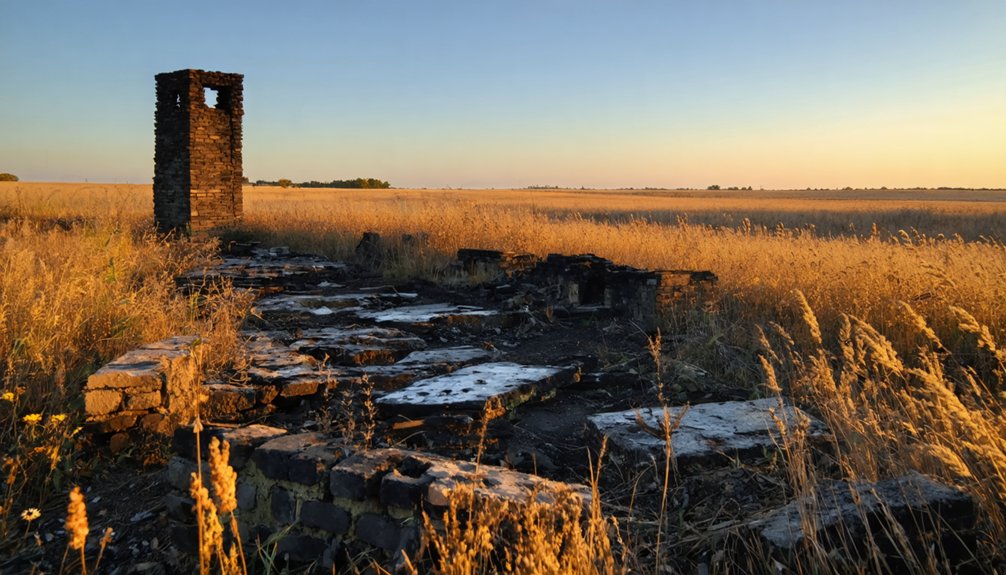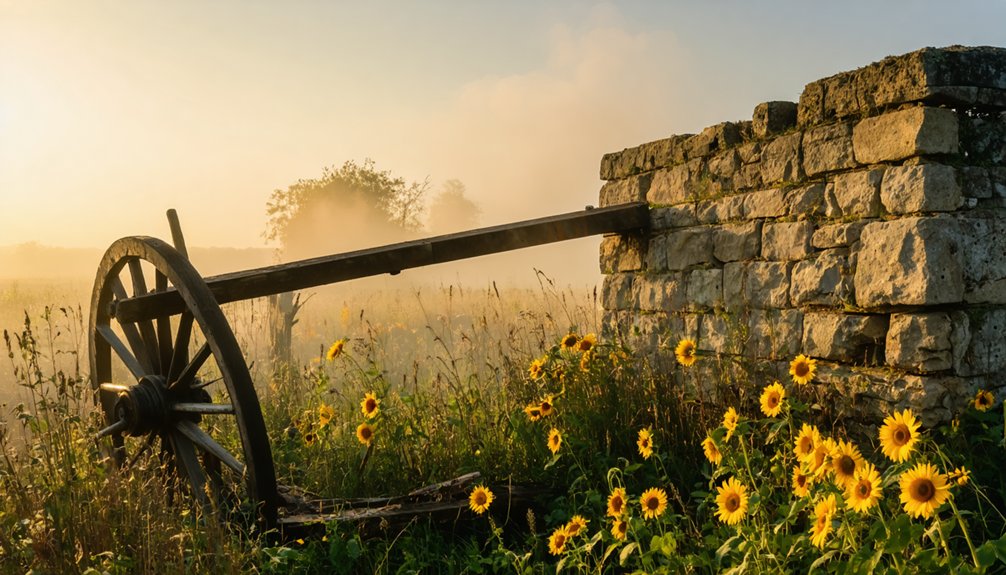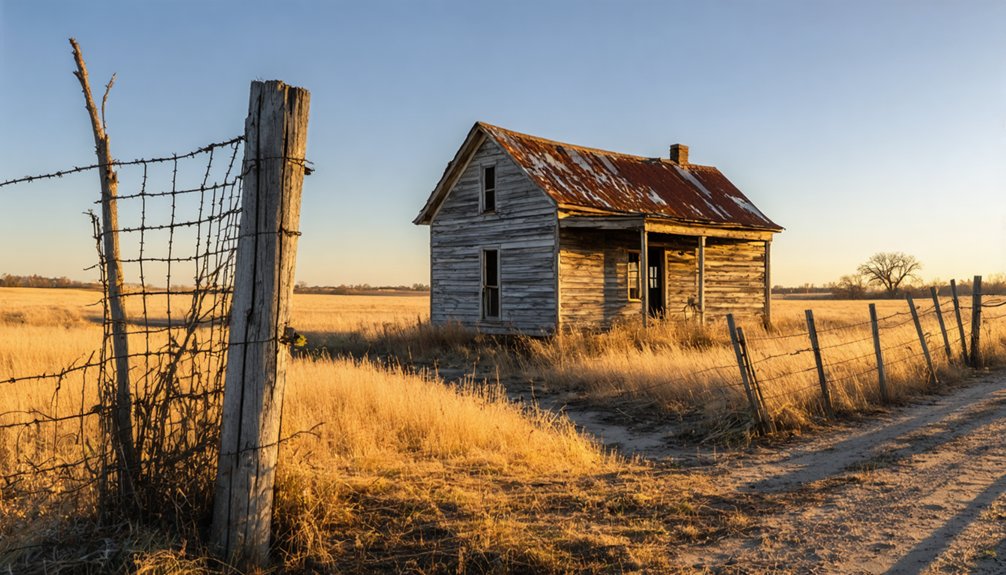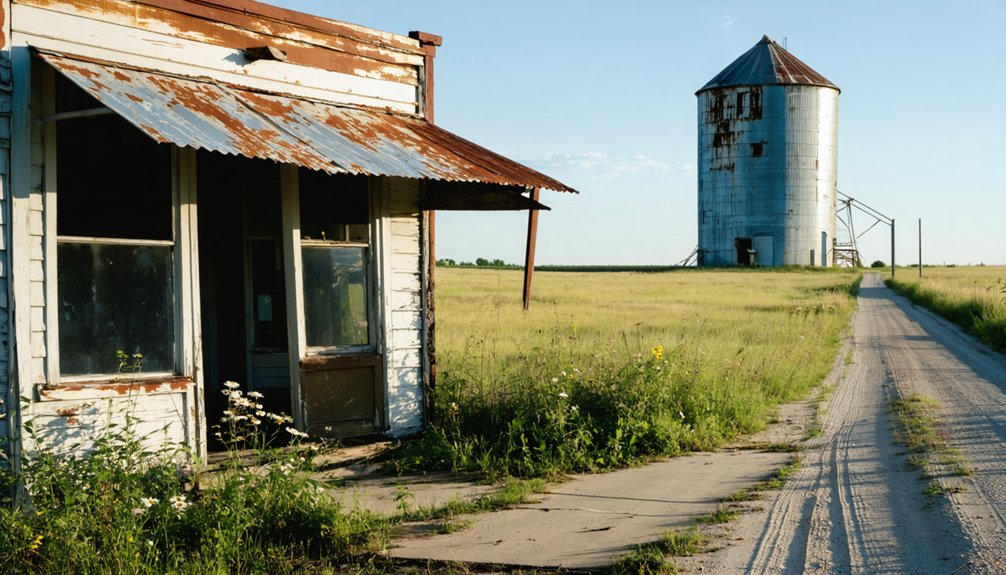You’ll find Iowa Point’s dramatic transformation in northeast Kansas, where it rose from just two buildings in 1854 to become the territory’s second-largest city by 1858. Founded by H.W. and J.W. Forman on former Ioway tribal lands, this Missouri River commercial hub thrived with stores, mills, and diverse immigrant populations. After the devastating Great Fire of 1862, the once-bustling frontier town gradually faded into a ghost town, though its archaeological treasures still tell tales of its glory days.
Key Takeaways
- Iowa Point was Kansas’s second-largest city in the late 1850s before declining to a ghost town following the devastating Great Fire of 1862.
- Only a few private residences remain at the original town site, with no surviving commercial buildings, post office, or railway structures.
- The town’s rapid decline was accelerated by sand deposits up to five feet deep following the fire, causing residents to migrate westward.
- Archaeological evidence, including stone axes and pottery found 8 feet deep, reveals the site’s extensive prehistoric use by Native Americans.
- The ghost town’s location along the Missouri River was once a thriving commercial hub with stores, mills, and diverse immigrant populations.
Origins of a Lost Frontier Town
As the Kansas Territory opened for settlement in 1854 under the Kansas-Nebraska Act, the landscape that would become Iowa Point underwent a pivotal transformation.
You’ll find the roots of this frontier settlement in the Ioway heritage of northern Doniphan County, where a strategic treaty transferred vast tracts of native land to U.S. control.
Within these newly available “Iowa Trust Lands,” missionary S.M. Irvin secured a 160-acre tract that would shape the town’s destiny.
The town’s founders H.W. and J.W. Forman established Iowa Point in 1855, marking the beginning of rapid frontier development.
By the late 1850s, the growing settlement had become Kansas’s second largest city, attracting merchants and settlers from across the region.
The Ioway Tribe’s Sacred Land
Before Iowa Point became a frontier settlement, you’d find the Ioway people living along the Missouri River, where they maintained sacred burial grounds and conducted ceremonies that unified their clans through holy pipe rituals.
The traditional Baxoje people, as they called themselves, held deep cultural and spiritual ties to this region.
You can trace their deep connection to this river valley through archaeological evidence of settlements dating back generations before European contact.
Their spiritual and ceremonial practices reflected a profound relationship with the land, particularly around the confluence of the Missouri and Big Nemaha Rivers where burial mounds and ceremonial sites served as focal points for tribal gatherings.
In 1836, the Ioway people experienced a significant change when they were relocated to Kansas, marking a new chapter in their historical connection to the region.
Sacred Burial Traditions
The Ioway tribe’s sacred burial traditions reflected deeply rooted spiritual practices that honored their deceased through carefully orchestrated ceremonies and rituals.
Influenced by their ancestral Woodland Culture builders, the tribe incorporated elements from their mound-building heritage into their burial practices. Their burial customs included wrapping the departed in their finest clothes with blankets or animal skins, while non-family members respectfully carried the body through windows. You’ll find that some clans chose ground burial while others preferred elevated platforms in trees.
At these sacred ceremonies, they’d make ancestral offerings including tobacco and dog meat to the Grandfathers, painting the deceased’s face with symbolic red or yellow powders. In the case of tribal leader Tohe, his remains were placed with his pony and belongings in a mound marked by a white flag.
The tribe maintained a year-long mourning period during which they suspended all ceremonies and dances. Family members would carry the deceased’s belongings to the burial site, maintaining their spiritual connection through carefully preserved traditions.
River Settlement Legacy
Sacred waters of the Mississippi and Missouri Rivers defined the ancestral homeland of the Ioway tribe, who controlled vast territories between these mighty waterways by the early 1700s.
You’ll find their river heritage deeply embedded in strategic settlements at key confluences, from the Rock River junction to the Des Moines River valley.
The settlement evolution of the Ioway reveals their masterful adaptation to riverine environments. Archaeological findings have confirmed their territorial claims between the rivers. They’ve maintained authority over these water routes, requiring consent from other tribes seeking to settle nearby.
Even as treaties pushed them southward to the Great Nemaha River reservation in 1836, they preserved their connection to these life-giving waterways.
Today’s Iowa Tribe of Kansas and Nebraska continues this river-based legacy on their 12,038-acre territory, carrying forward centuries of tradition. The tribe’s strength endured despite smallpox epidemics that reduced their population to 800 by 1804.
Chief Ma-Hush-Kah’s Legacy
Leading the Ioway tribe during the early to mid-1800s, Chief Ma-Hush-Kah (also known as Mahaska II or White Cloud) established his presence along the Missouri River in a distinctive double-hewed log house at Iowa Point.
His Ioway leadership shaped the region’s dynamics, particularly through ongoing conflicts with the Pawnee tribe, which ultimately led to his death in battle in 1854.
You’ll find Ma-Hush-Kah’s lasting influence throughout the area, from the naming of White Cloud, Kansas, to the preservation of tribal heritage in local museums. The Ma-Hush-Kah Historical Society now manages a museum dedicated to preserving local and tribal history.
After his death near a large tree overlooking the Missouri River, leadership passed to Nan-cha-nin-ga (No Heart).
The chief’s legacy lives on through modern initiatives like the Ioway Bee Farm, which connects ancestral lands to contemporary tribal enterprises. Today, the Iowa Tribe retains 2,100 acres of reservation land spanning northeast Kansas and southeast Nebraska.
Rise to Regional Prominence
You’ll find Iowa Point’s rapid ascent began with its prime location on the Missouri River, where steamboats and the Chicago, Burlington & Quincy Railroad converged to create a bustling transportation hub in 1855.
Between 1855 and 1858, the town’s population swelled as merchants like Beeler & Williams and Stout & Richard Leach established the first general stores, while B. Beeler opened the settlement’s inaugural hotel.
The town’s strategic position and growing commercial district soon made it the second-largest city on the Missouri River in Kansas Territory, serving as a crucial gateway for settlers and trade flowing into the newly opened lands.
Strategic Missouri River Location
Iowa Point’s strategic position along the Missouri River established its rapid ascent as a commercial powerhouse in mid-19th century Kansas Territory.
You’ll find its location was masterfully chosen, offering access to river trade routes that stretched over 100 miles in multiple directions.
The town’s transportation infrastructure expanded remarkably in 1858 when H. Forman launched steam ferry operations, connecting essential cross-river commerce.
The Missouri River location proved so important that Kansas troops were stationed there in 1862 to protect these critical transportation routes during the Civil War.
When combined with the Chicago, Burlington & Quincy Railroad connection, Iowa Point’s position created a perfect hub for wholesale distribution, allowing merchants to move goods efficiently throughout the region.
Rapid Population Growth 1855-1858
Three ambitious founders – H.W. Forman, J.W. Forman, and J.S. Pemberton – established Iowa Point in early 1855, triggering rapid population dynamics that transformed this Missouri River settlement into Kansas’s second most populous city by 1858.
You’ll find that settlement patterns evolved quickly from two initial buildings in 1854 to a thriving commercial hub rivaling Leavenworth.
- A $10,000 hotel, brick buildings, and wholesale houses serving customers within a 100-mile radius
- Multiple sawmills and grist mills powering local industry and commerce
- Religious institutions including Presbyterian, Methodist, and Baptist congregations
- Diverse immigrant populations, particularly Germans and Irish, providing labor and commercial demand
The town’s strategic location attracted merchants, craftsmen, and immigrants seeking opportunity, while essential infrastructure like Forman’s steam ferry service strengthened Iowa Point’s regional prominence.
Early Commercial Hub Development
Within months of its founding in 1855, the strategic settlement at Iowa Point rapidly evolved into a bustling commercial center, anchored by Beeler & Williams‘ pioneering general store.
You’d have found impressive early entrepreneurship as additional merchants like Stout and the Leach brothers established competing stores, while Leigh & Brown opened the area’s first drug store and Burkhalter & Hobbs launched a thriving meat market.
Commercial diversity expanded further when Forman & Pemberton built both a sawmill and grain processing facility, while Boliver Beeler constructed the town’s first hotel.
Life Along the Missouri River
Life along the Missouri River evolved dramatically over thousands of years, from the earliest Indigenous inhabitants who settled the watershed 12,000 years ago to the arrival of European settlers in the 1800s.
You’d have found Indigenous Agriculture thriving by 1000 A.D., with tribes like the Kansa cultivating corn, squash, and beans near the riverbanks.
River Navigation transformed from simple dugouts and bull boats to more sophisticated ferry systems that’d shape the region’s development.
- You could’ve witnessed seasonal village life, where tribes combined buffalo hunting with riverside gardening.
- Early settlers adapted Indigenous transportation methods before developing their own ferry networks.
- You’d have seen diverse cultures collide as steamboats brought waves of new settlers.
- The river served as your lifeline, providing fish, transportation, and fertile soil for farming.
The Great Fire of 1862

Flames from the Great Fire of 1862 ravaged the Missouri River valley, devastating settlements around Iowa Point and forever altering the region’s development. The fire’s aftermath left deep scars, with sand deposits up to five feet deep where homes and warehouses once stood.
You’d have witnessed entire families displaced, while young men chose to venture westward rather than rebuild.
During this period of natural disaster, you couldn’t escape the broader context of the Missouri-Kansas border conflict. Union forces increased their presence to protect against bushwhacker raids while communities showed remarkable resilience.
Together, military and civilian efforts focused on rebuilding with stronger materials, particularly brick structures and reinforced church buildings. The fire transformed Iowa Point’s landscape, prompting revised town planning and affecting river commerce as damaged landings disrupted crucial trade routes.
Ghost Hollow Mysteries
When you visit Ghost Hollow near Iowa Point today, you’ll discover a rich tapestry of Native American legends intertwined with more recent paranormal accounts from the area’s tragic past.
You’ll find the hollow’s dark waters reflect centuries of local lore, from the earliest Ioway tribe stories to tales of mysterious deaths and unexplained phenomena that continue to draw ghost hunters to the site.
The site’s most famous story centers on Molly, whose reported screams still echo through the hollow, adding to the location’s reputation as one of Kansas’s most haunted places.
Native Legends Live On
Deep spiritual connections to Ghost Hollow persist through Native American legends, particularly in Sioux and Dakota traditions that frame the area as a domain of supernatural forces.
You’ll find the name “Sica” itself warns of evil in the Dakota language, while red-tinted springs serve as physical reminders of the supernatural phenomena believed to dwell there.
As settlers arrived, these Native spirits and stories blended with European folklore, creating a rich tapestry of paranormal tales that continue to shape the hollow’s mysterious identity.
- Ancient Sioux legends tell of spirit battles and supernatural vengeance
- The Trail of Spirits remains associated with ongoing mystical activity
- Red mineral springs were interpreted as signs of evil forces
- Stories of disappearances in the 1970s renewed interest in Native folklore
Dark Waters Below
Through murky waters and shadowy depths, “Dark Waters Below” draws readers into a haunting mystery set within Ghost Hollow’s abandoned grounds.
You’ll follow a determined team of investigators as they unravel mysterious disappearances connected to the dark waters beneath this isolated town. As you venture deeper, you’ll discover underwater secrets lurking in submerged caves and flooded mines, while fog and darkness heighten the tension around every corner.
The story masterfully weaves together natural dangers with supernatural elements, as skeptics and believers alike confront spectral figures tied to tragic local history.
You’ll encounter conflicted characters whose personal connections to Ghost Hollow reveal buried truths, while the haunting atmosphere of this Midwestern setting mirrors Iowa Point’s own ghostly legacy.
Civil War’s Impact

As the Civil War erupted in 1861, Iowa Point’s strategic location on the Missouri River thrust it into a significant defensive role along the Kansas-Missouri border. Under Captain C.J. Beeler’s leadership, local citizens formed a militia to protect against guerrilla raids and military surveillance from Missouri.
The Eighth Kansas regiment stationed troops here in 1862, transforming the town into a critical supply point for Union forces.
- Quantrill’s Raiders terrorized nearby Kansas towns, intensifying the need for constant vigilance
- The town’s rail connection to the Chicago, Burlington & Quincy Railroad made it essential for troop movements
- Local men’s enlistment strained the population and disrupted daily commerce
- The war’s violence discouraged settlement, eventually contributing to the town’s decline
Surviving Structures Today
The sparse remnants of Iowa Point tell a quiet tale of architectural survival, with only a handful of private residences still standing at the original town site.
You’ll find no intact commercial buildings, post office, or railway structures from Iowa Point’s heyday – they’ve all vanished with time. The surviving homes remain largely due to limited funds for demolition or new construction, a common pattern in Kansas ghost towns.
While approximately 100 local residents live in the general vicinity, you won’t see many visible ruins marking the town’s original footprint.
If you drive along Highway 7’s Glacial Hills Scenic Byway today, you’ll encounter mostly open rural landscapes where this once-thriving town stood, with just a few weathered houses as silent witnesses to Iowa Point’s past.
Tales From Eagle Springs

Nestled between Troy and Iowa Point along U.S. Highway 36, you’ll discover the ghostly allure of Eagle Springs, a once-thriving health resort that captivated visitors in the 1880s and 1890s.
The resort’s owners, Prior Plank and Peter Weidemeier, even captured a live eagle as their mascot to promote their enterprise.
In a bold marketing move, Eagle Springs’ proprietors kept a captured eagle on display to attract visitors to their healing resort.
- Springs were believed to possess miraculous healing properties and promise eternal youth
- Native Americans left behind stone axes, pottery, and arrowheads buried up to 8 feet deep
- Archaeological evidence reveals extensive prehistoric use through ash heaps and animal bones
- The resort featured multiple hotels and amenities until its financial collapse in 1937
Today, while no original structures remain standing, you can still explore the swimming pool ruins and natural springs that once drew thousands seeking cures in this scenic landscape near Lookout Mountain.
Frequently Asked Questions
What Was the Highest Recorded Population of Iowa Point During Its Peak?
You’ll find the highest recorded population growth reached over 3,000 residents during the peak years of the 1850s, making it the second largest Missouri River city after Leavenworth.
Were There Any Famous Outlaws or Notable Figures Who Visited Iowa Point?
Ever wonder about outlaw encounters in frontier towns? While you won’t find famous bandits in Iowa Point’s story, you’ll discover Chief Ma-Hush-Kah and notable visitors like W.J. Gatling and Cornelius Dorland.
How Did Residents Get Their Mail and Supplies During Winter Months?
You’d receive mail delivery through the post office, relying on stagecoaches until winter hit. For winter supplies, you’d stock up via riverboats and nearby railroad stations, while sharing resources with neighbors during harsh conditions.
What Happened to the Original Town Records After the Decline?
After an 1862 fire destroyed 80% of Iowa Point’s structures, you won’t find the original records. They weren’t historically preserved, likely deteriorating on-site or burning, with no evidence of transfer to official repositories.
Did Any Industries Besides Agriculture and River Trade Exist in Iowa Point?
You’ll find diverse industries flourished there: sawmills processed timber, brick-yards produced building materials, wholesale merchants operated regionally, and steam ferries provided transportation. Mills and hotels also drove the local economy.
References
- https://esirc.emporia.edu/bitstream/handle/123456789/1577/McQuin Vol 8 Num 3.pdf
- https://www.legendsofamerica.com/ks-whitecloud/
- https://www.youtube.com/watch?v=A7guEY4xsug
- https://www.kancoll.org/books/cutler/doniphan/doniphan-co-p14.html
- https://www.youtube.com/watch?v=VPZtNoncnig
- https://www.ksgenweb.org/archives/1912/i/iowa_point.html
- https://legendsofkansas.com/iowa-point-kansas/
- https://dianastaresinicdeane.wordpress.com/2012/01/29/columbia-a-kansas-ghost-town-story/
- https://en.wikipedia.org/wiki/Ioway_Tribal_National_Park
- https://greysnow.com/our-tribe/



